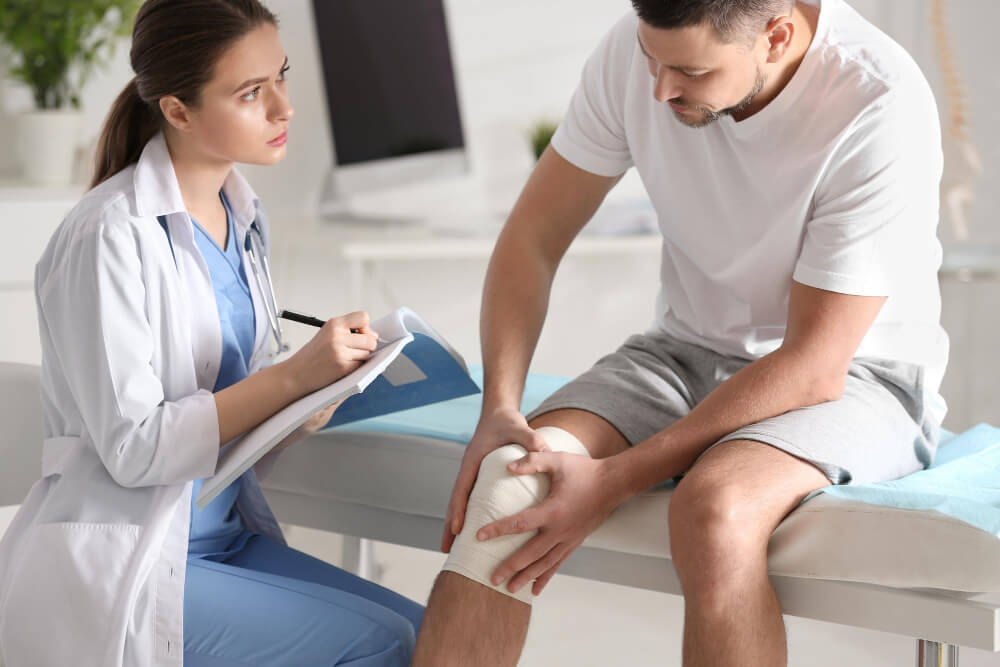Orthopedic doctors specialize in diagnosing, treating, and preventing disorders of the musculoskeletal system, which includes bones, joints, ligaments, tendons, and muscles. They commonly address issues such as fractures, arthritis, sports injuries, and spinal conditions. These doctors may use a variety of treatments, including medication, physical therapy, surgery, and other interventions to help patients regain mobility and reduce pain.
Knee transplants, also known as knee replacements, are surgical procedures where a damaged knee joint is replaced with an artificial one made of metal and plastic components. It’s typically done to relieve pain and restore function in severely damaged knees due to conditions like osteoarthritis or injuries. Rehabilitation after surgery is crucial for recovery and regaining mobility.
There are two main types of knee transplants:
Total Knee Replacement (TKR): This involves replacing the entire knee joint with artificial components. It’s typically done when the entire knee is damaged due to arthritis or injury.
Partial Knee Replacement (PKR): In this procedure, only the damaged part of the knee joint is replaced with an artificial component. It’s suitable for patients with localized knee damage, often caused by osteoarthritis.
Choosing a knee transplant, whether total or partial, is often recommended when conservative treatments like medication and physical therapy no longer provide adequate relief for knee pain and dysfunction. Some benefits of knee transplants include:
- Pain relief: One of the primary reasons for choosing knee replacement surgery is to alleviate chronic knee pain that significantly impacts daily activities.
- Improved mobility: By replacing damaged knee joints with artificial ones, patients often experience improved range of motion and mobility, allowing them to engage in activities they couldn’t do before.
- Enhanced quality of life: Knee transplants can restore functionality, enabling patients to resume normal activities and enjoy a better quality of life.
- Long-term solution: Knee replacements are durable and can last for many years, providing long-term relief from pain and disability for most patients.
- Reduced dependency on medications: After successful knee replacement surgery, patients may require fewer pain medications, reducing the risk of medication-related side effects and dependency.
- Better sleep: Relief from chronic knee pain can lead to improved sleep quality, as patients are no longer kept awake by discomfort.
Overall, the decision to undergo knee transplant surgery is based on individual circumstances and should be made in consultation with a healthcare provider after considering factors such as the severity of knee damage, age, lifestyle, and overall health.
Arthroplasty, commonly known as joint replacement surgery, is a medical procedure that has revolutionized the treatment of debilitating joint conditions. Whether due to injury, degenerative diseases like osteoarthritis, or other factors, damaged joints can significantly impair mobility and quality of life. In this blog, we delve into the world of arthroplasty, exploring its types, benefits, advancements, and what to expect from the procedure.
Types of Arthroplasty:
Total Hip Arthroplasty (THA): THA involves replacing both the acetabulum (hip socket) and the femoral head (top of the thigh bone) with artificial components made of metal, ceramic, or plastic. This procedure is often recommended for severe hip arthritis or fractures.
Total Knee Arthroplasty (TKA): TKA replaces the damaged knee joint surfaces with metal and plastic components. It’s a common treatment for advanced knee osteoarthritis, restoring mobility and reducing pain.
Total Shoulder Arthroplasty (TSA): TSA replaces the damaged shoulder joint with artificial components, often recommended for conditions like severe arthritis or rotator cuff tears.
Benefits of Arthroplasty:
Pain Relief: One of the primary goals of arthroplasty is to alleviate chronic joint pain, enabling patients to engage in daily activities without discomfort.
Improved Mobility: By replacing damaged joint surfaces with prosthetic components, arthroplasty restores mobility, allowing patients to move more freely and participate in activities they enjoy.
Enhanced Quality of Life: Restoring joint function and reducing pain can significantly enhance the overall quality of life for individuals undergoing arthroplasty.
What to Expect:
Before the Procedure: Patients undergo a thorough evaluation to assess their candidacy for arthroplasty. Preoperative preparations may include medical tests, discussions about implant options, and lifestyle modifications.
During the Procedure: Arthroplasty is typically performed under general or regional anesthesia. The surgeon removes the damaged joint surfaces and implants the prosthetic components, ensuring proper alignment and stability.
After the Procedure: Following surgery, patients undergo a period of rehabilitation, including physical therapy to regain strength and range of motion. Pain management strategies are implemented to ensure a comfortable recovery process.
Arthroscopy, derived from the Greek words “arthro” (joint) and “skopein” (to look), involves the insertion of a small camera, called an arthroscope, into a joint through a tiny incision. This device transmits images to a monitor, enabling surgeons to visualize the internal structures of the joint in real-time.
Applications and Benefits:
Diagnostic Precision: Arthroscopy provides detailed visualization of joint structures, aiding in the accurate diagnosis of various conditions such as torn ligaments, cartilage damage, and joint inflammation.
Minimally Invasive Surgery: Compared to traditional open surgery, arthroscopic procedures involve smaller incisions, resulting in reduced trauma to surrounding tissues, less postoperative pain, and faster recovery times.
Therapeutic Interventions: Beyond diagnosis, arthroscopy allows for therapeutic interventions, including repairing ligaments, trimming damaged cartilage, removing loose bodies, and addressing joint abnormalities.
Multi-Joint Applications: While commonly associated with knee arthroscopy, this technique is also utilized in other joints such as the shoulder, hip, ankle, wrist, and elbow, expanding its utility across orthopedic specialties.
In conclusion, arthroscopy stands as a cornerstone of modern orthopedic practice, revolutionizing the diagnosis and treatment of joint disorders. With ongoing technological advancements and innovations, its role in promoting joint health and restoring function continues to evolve, promising a brighter future for patients worldwide. Orthopedic doctors specialize in diagnosing and treating conditions related to the musculoskeletal system. They play a crucial role in helping patients recover from injuries, manage chronic conditions, and improve overall mobility and quality of life. With their expertise, they offer a range of treatments, from conservative approaches like physical therapy to surgical interventions when necessary. Overall, orthopedic doctors are vital in ensuring optimal bone, joint, and muscle health for their patients.
Contact Us
Website – https://www.drsunilrajan.com
Contact Number – 9826200015
Email – drsunilrajan@gmail.com



